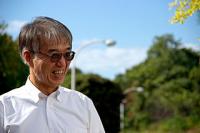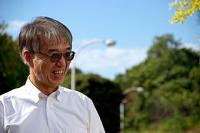2016-03-17 Koide Hiroaki: an insider's exposé of the Fukushima nuclear disaster
Koide Hiroaki has spent his entire career as a nuclear engineer, and has become a central figure in Japan's movement for the abolition of nuclear power plants.
'Koide: Well ... the danger corresponds to the amount of exposure-you probably know this - so for a country that has declared its intention to maintain the 1mSv/yr standard to then turn around and ask people to endure twenty times that level, there is no scientific basis for that declaration. That's a social decision.
But if you want to inquire as to why, as I've mentioned to you, some 2.4 petaBecquerels of radioactive material have fallen on Japan, that material has been dispersed, contaminating Tohoku, Kanto, and western Japan. So in addition to the law setting the legal limit for exposure at 1mSv/yr, there is another law that states that absolutely nothing may be removed from a radioactive management area in which the levels exceed 40,000 Becquerels per square meter.
So the question becomes how many places or how much area has been contaminated beyond 40,000 Bq/m2? And according to the investigations, that answer is 140,000 km2. The entirety of Fukushima prefecture has been contaminated to where all of it must be declared a radioactivity management area.
Indeed, while centred on Fukushima, parts of Chiba and Tokyo have also been contaminated. The number of people living in what must be called a radiation-controlled area is in the millions, and could exceed ten million'.
'Koide: Yes. For humans going there means instant death, so the only way at all is to use robots. But robots are extremely vulnerable to radiation. Consider, robots receive their instructions through series of 1s and 0s, so should the radiation switch a 0 to a 1 you'd end up with completely different instructions.
Essentially robots are useless. Even if you are able to send them in they can never return. Because this has been the case up to now, the only way left in the end might be to use robots that try to avoid exposure or that are built as much as possible to withstand exposure, but that is no simple thing.
So it means until we figure out what to do it would still take many years. Once you understand this fact you can start thinking about what can be done. And at the very least the 'road map' devised by the government and TEPCO is the most absolutely optimistic road map that there could be.
They are convinced that the melted core fell through the bottom of the pressure vessel and now lie at the bottom of the containment vessel-basically piling up like nuggets of the melted core. There's no way this would be the case. (Laughs)'.
'In my view, Fukushima should be declared uninhabitable and the government and TEPCO should bear a legal responsibility for the people displaced and dispossessed by the nuclear disaster. That's what I think, but if that were to be done, it would likely bankrupt the country. I think that even though it could bankrupt Japan, the government should have carried out the evacuation to set an example of what the government is supposed to do.
But obviously those in and around the LDP certainly didn't agree. They've decided to sacrifice people and get by taking on as little burden as possible. So they've made the social decision to force people to endure their exposure. In my view, this is a serious crime committed by Japan's ruling elite.
I would like people to know just how many thousands of people live in this abnormal situation where even nuclear scientists like me are not allowed to enter, not to mention, drink the water. It is strange that this issue has been left out of all debate over the effects of the radioactive exposure.
We must be aware that contemporary Japan continues to operate outside the law in abandoning these people to their fate by saying it's an extraordinary situation. Under such circumstances, I think, there are a multitude of symptoms of illnesses in contaminated areas. But if we're talking about any given symptom, it's hard to say since we just don't have any good epidemiological studies, or even any good data. But there will surely be symptoms, namely cancer and leukaemia'.
Original article: 2016-03-17 Koide Hiroaki: an insider's exposé of the Fukushima nuclear disaster
I found that it read very well. He clearly knows the nuclear engineering and is aware of the health effects of radioactivity and the need for epidemiological studies.
Koide Hiroaki has spent his entire career as a nuclear engineer, and has become a central figure in Japan's movement for the abolition of nuclear power plants.

Recent articles
2024-07-12 The Road to Net Zero Can Save Government Funds
Action Government SavingRemove government funding of Sizewell C, SMR, ANF and FNEF £ 1155 millionRemove government funding of nuclear fusion Up to £ 650 million to 2027Remove tax relief for the oil and gas industry Up to £ 5.7 billion/y from 2022 to 2025Remove government funding of CCS £ 20 billion over 20 years from 2023Remove government funding of imported biomass for Drax etc £ 606.8 million in 2022Total of above About £ 8.6 billion a year2024-10-12 A Note on Climate and Energy
I watched videos on climate change by Professors Johan Rockstroem and Stefan Rahmsdorf of the Potsdam Climatological Institute in Germany.This prompted me to create the document ‘2024-10-12 A Note on Climate and Energy’.2024-09-17 Britain’s Atomic Bomb Scandal (Channel 4 programme)
Channel 4 made a multi-part series of programmes with this title.The sub-title was: The dramatic, shocking story of Britain’s race for the nuclear bomb, the devastating fallout for the servicemen at the tests, and the veterans’ long fight for justice'. I watched all the parts, and made notes.Then I typed up the notes and followed up mentions and links to produce this document.2021-09-29 Nuclear Power and the EU Taxonomy
Around September 2021, the European Commission considered the inclusion of nuclear power in the taxonomy for future investments in energy. This was based on a single report from the European Joint Research Centre, which still has close links with the nuclear industry and is widely perceived as playing a promoting role for nuclear energy within the European Union. The JRC Report ignored the report of the German Ethics Commission for a Safe Energy Supply of 2011, which had lead to Germany phasing out nuclear power by 2023. The European Commision also ignored 'Sustainability at risk, A critical analysis of the EU Joint Research Centre technical assessment of nuclear energy with respect to the "do no significant harm" criteria of the EU Taxonomy Regulation, of 2021-09 by Dr. Christoph Pistner, Dr. Matthias Englert and Dr. Ben Wealer, for the Heinrich Boell Foundation.2023-06-06 Nuclear Power Has No Future
The UK government proposes to build nuclear power plants totalling 24 GW.This implies Hinkley Point C, Sizewell C and about six more of similar size.The Labour party proposes to include nuclear power in it’s new ‘green’ energy policy.Yet nuclear power has no future, as shown in this document of 3 pages with 52 references. The first section shows that nuclear fuel may be effectively exhausted before 2050, when the climate targets should be met. The second section shows that the costs of nuclear power have risen over time, and are now uncompetitive. So nuclear power must be replaced by sustainable and affordable options such as energy savings and renewables like wind, solar and storage. The third section shows that nuclear power conflicts with energy savings and renewables, so impairing the business case and deterring investment.So the UK should phase out nuclear power and join the rest of the world in deploying energy savings and renewables.Although this document is published after the latest Government and Labour Party proposals,I have published many earlier documents on nuclear power, dating from 2006-0-19. (See below).Most notably, my report on the Fukushima disaster was published on 2012-04-11, with copies sent to several MPs and Ministers.2022-10-05 Nuclear Nonsense
The new UK government appears to support the previous government’s proposal of building new nuclear power plants. The Labour party proposes to include nuclear power in it’s new ‘green’ energy policy. However such nuclear proposals are nonsense, as shown in this 4-page due diligence assessment.2022-08-12 Stopping Sizewell C and all nuclear power in favour of a rational energy policy
Among the last acts of the Johnson government was the approval of a new nuclear plant - Sizewell C. The claim was that it would increase energy security and reduce carbon emissions. But the invasion of Ukraine has underlined that all nuclear sites are targets, and reduce national security. Also nuclear power would be far more costly than energy savings and renewable energy sources such as wind and solar, with storage, and could not be generating electricity before 2030. They need uranium for fuel, yet almost half comes from Russia and Kazachkstan, so that the money and carbon costs would increase twice as fast. Moreover, they require huge amounts of energy to manufacture and build, so reducing energy security until construction is complete, and this energy repaid. Yet Hinkley Point C and Sizewell C are coastal sites, at risk from flooding by sea level rise and storm surge by 2100. As decommissioning and site clearance would take at least 50 years, they would need to be shutdown before 2050. Many reasons for stopping Sizewell C and all nuclear power are given in this collection of five documents.2022-08-13 Nuclear Power And Weapons Are Killing Us
The Manhattan Project in the US covered every stage of the production of nuclear weapons. This included the mining and refining of uranium, enrichment to 80 to 90% U235 for uranium bombs, fuelling nuclear reactors with uranium to produce plutonium, and reprocessing the spent fuel to extract the plutonium for plutonium bombs. It was recognised from the beginning that these processes and plants would give rise to radioactive releases that would be harmful to the plant operators and the general public, yet they were never informed. This continues to the present day, when the nuclear weapon and power industry does everything in its power to deny and understate the many and extensive harms done to all living things. To this has been added the use of uranium in bunker-breaking bombs and tank-busting shells, that spread the dust so formed over their own forces, the enemy forces, and innocent bystanders, harming them all for generations to come. The human harms include many and extensive cancers, and also non-malignant diseases such as stillbirths, deformities and mental impairment and heart disease. With so much harm already done to humans that will take up to lifetimes to express, and so much nuclear debris laying in wait to harm even more humans, it is essential to identify every strategy and measure that can reduce the total harm.This document covers the first warnings of nuclear harms in the 1950s and - following studies beginning in the 1960s - five books of evidence by Dr Ernest Sternglass in 1981, Mr Harvey Wasserman et al in 1982, Dr John Gofman in 1990, Mr Paul Zimmerman in 2009, and Professor Chris Busby et al in 2010.2022-06-14 Energy Transition Technologies
This is prompted by the Energy Hierarchy of the Institution of Mechanical Engineers. From the most to the least sustainable, Tier 1 is Energy Demand Reduction, Tier 2 is Energy Efficiency, Tier 3 is Utilisation of Renewable, Sustainable Resources, Tier 4 is Utilisation of Other, Low-GHG-Emitting Resources, and Tier 5 is Utilisation of Conventional Resources as we do now.2022-06-18 Nuclear Insecurities
This is a three-page re-cast of 2016-08-09 Nuclear Insecurities (below).It includes 16 criteria under the original 10 headings, supported by 21 references.




